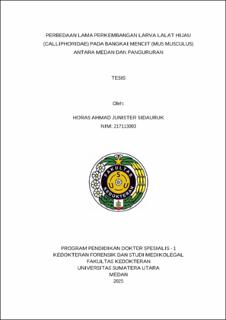Perbedaan Lama Perkembangan Larva Lalat Hijau (Calliphoridae) pada Bangkai Mencit (Mus Musculus) antara Medan dan Pangururan
Differences in Development Length Green Bottle Fly Larvaes (Calliphoridae) on Mice (Mus musculus) Carcass Between Medan City and Pangururan City

Date
2025Author
Sidauruk, Horas Ahmad Junister
Advisor(s)
Sitepu, Agustinus
Marbun, Doaris Ingrid
Metadata
Show full item recordAbstract
Background : The epidemiology of the death case of Mr. X's body and the mystery behind the cause of his death occur all over the world. The city of Medan, which last year was statistically the city with the second highest crime rate in Indonesia, was not spared from the case of Mr. X. Determining how long the victim has been dead is often very important information in revealing the identity and cause of the death. Investigations conducted through forensic entomology approaches are able to determine the growth and development of insects that are possible in estimating when the victim died. In addition, identification of insect types can also be used to find out if the body has been moved from one location to another. The insect that is often used in determining the estimated time of death is the fly. The first flies to land on the body are generally the species of green flies that come from the most accurate family. This difference in location implies that places that have different environmental climatic conditions, especially daily temperatures, show differences in influencing the development of the larval stage or life cycle so that it can cause potential errors in determining PMI. research to see how the development of green fly larvae is compared between Pangururuan and Medan. In this study, various environmental variables that can affect the development of green fly larvae such as temperature, altitude and daily weather conditions and the difference in development time in both places will be measured.
Method : This study uses an analytical descriptive approach with a prospective research design. Variables were measured at the same time as the study took place. The study used primary data to determine the development of green fly larvae in mouse carcasses in the Medan and Pangururan areas. The study was conducted with a sample of 10 (ten) mice (Mus musculus) aged 2-3 months with a weight of 20-25 grams and pre-adult green flies in the carcass of mice. Where in each location 5 (five) mice are used, namely 5 (five) in Medan and 5 (five) in Pangururan. The research was conducted at different times at each research location. The research began in Pangururan and then in Medan. Samples of mice at each research location were killed by Cervical dislocation treatment. The mice that had died were then given a 10 cm incision in the abdominal area. The observation began when the green fly began to come and land on the carcass of the mice and was recorded as H0. After a while, green flies were caught around the carcass using an insect net (sweeping net) and put into an insect cage (insect cage in the form of a mosquito net) along with the carcass of the mouse. Larval samples are taken every morning and evening to be examined until finally larvae that have reached the pupa phase are found.
Results : There is a difference in the development time of Green Fly larvae (Calliphoridae) in Medan and in Pangururan. The total duration of larval development until the appearance of the adult Green Fly (Calliphoridae) phase in Medan is 10 (ten) days and the total duration of larval development until the appearance of the adult Green Fly (Calliphoridae) phase in Pangururan is 11 (eleven) days. The time difference between larval development and the appearance of the adult Green Fly (Calliphoridae) phase between Medan and Pangururan is 1 (one) day.
Collections
- Master Theses [44]
